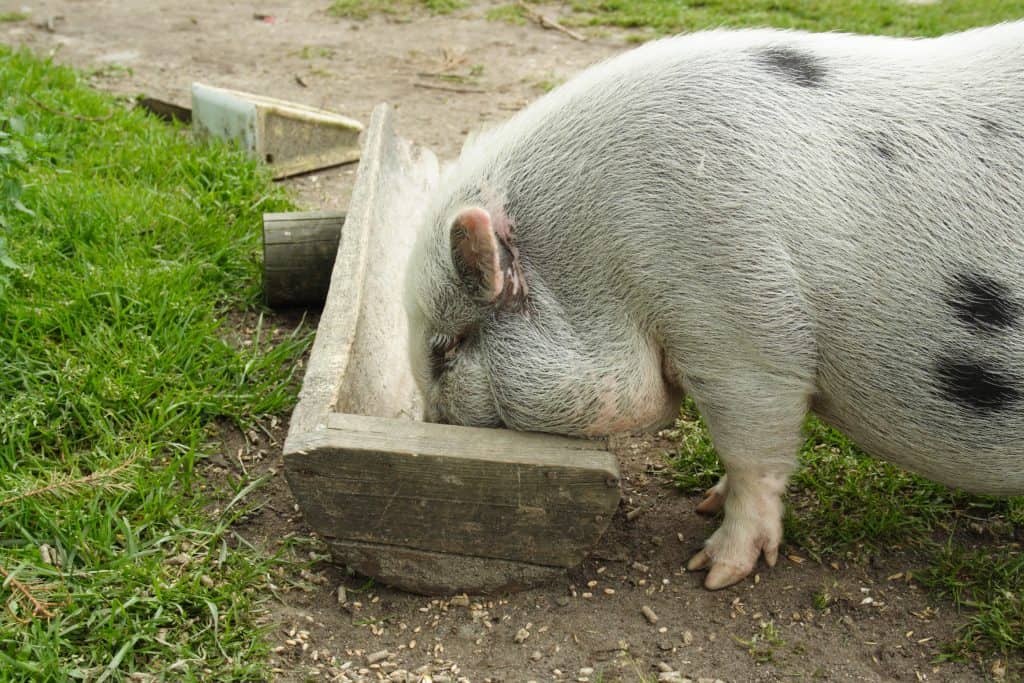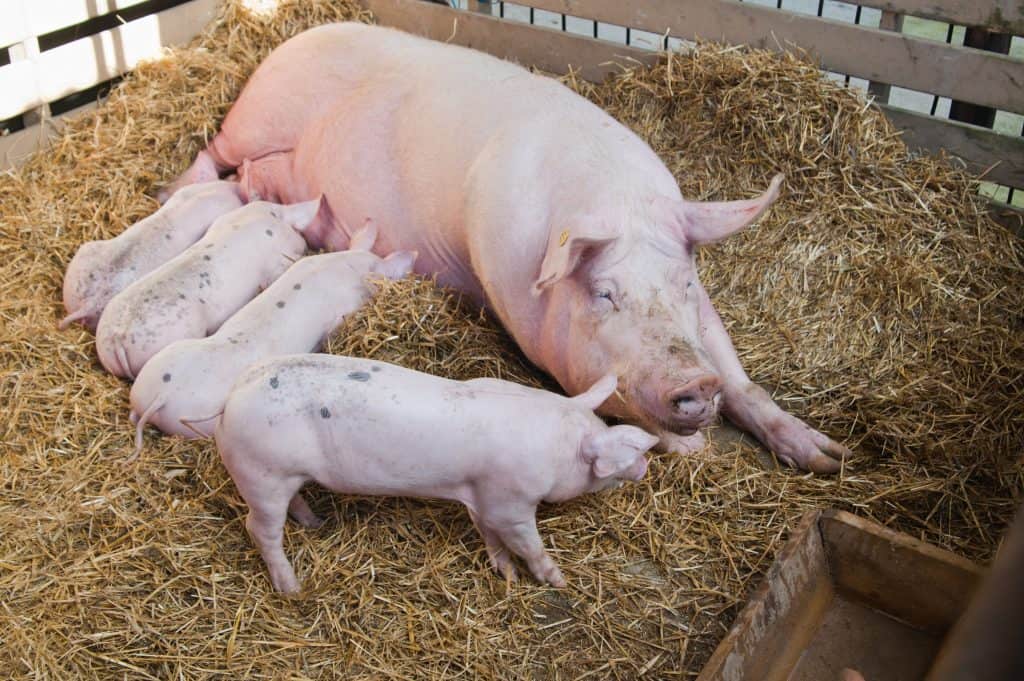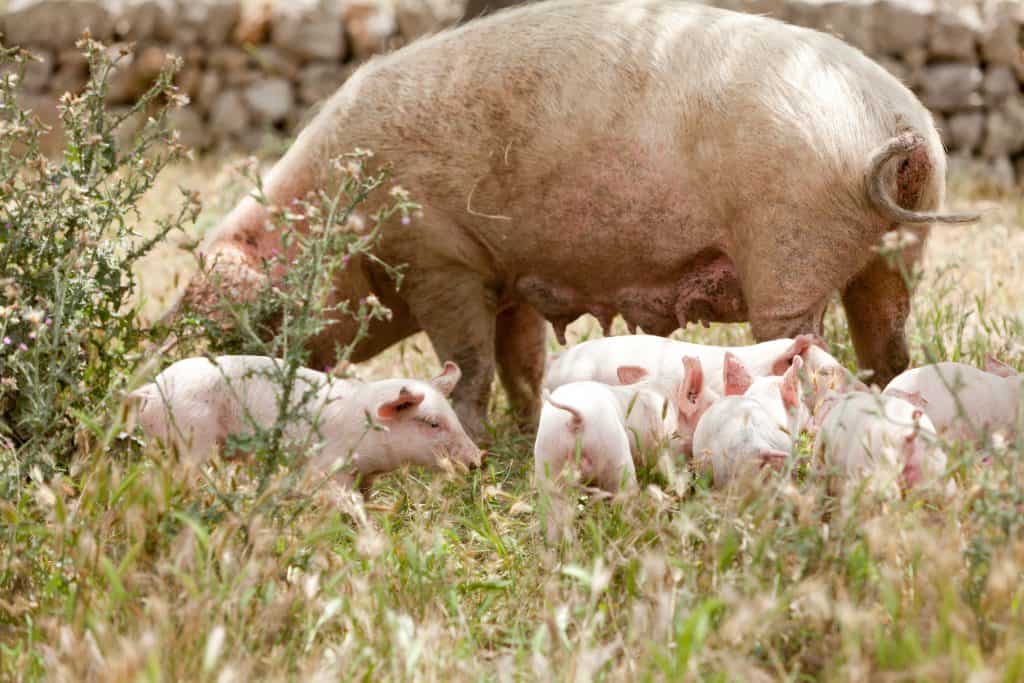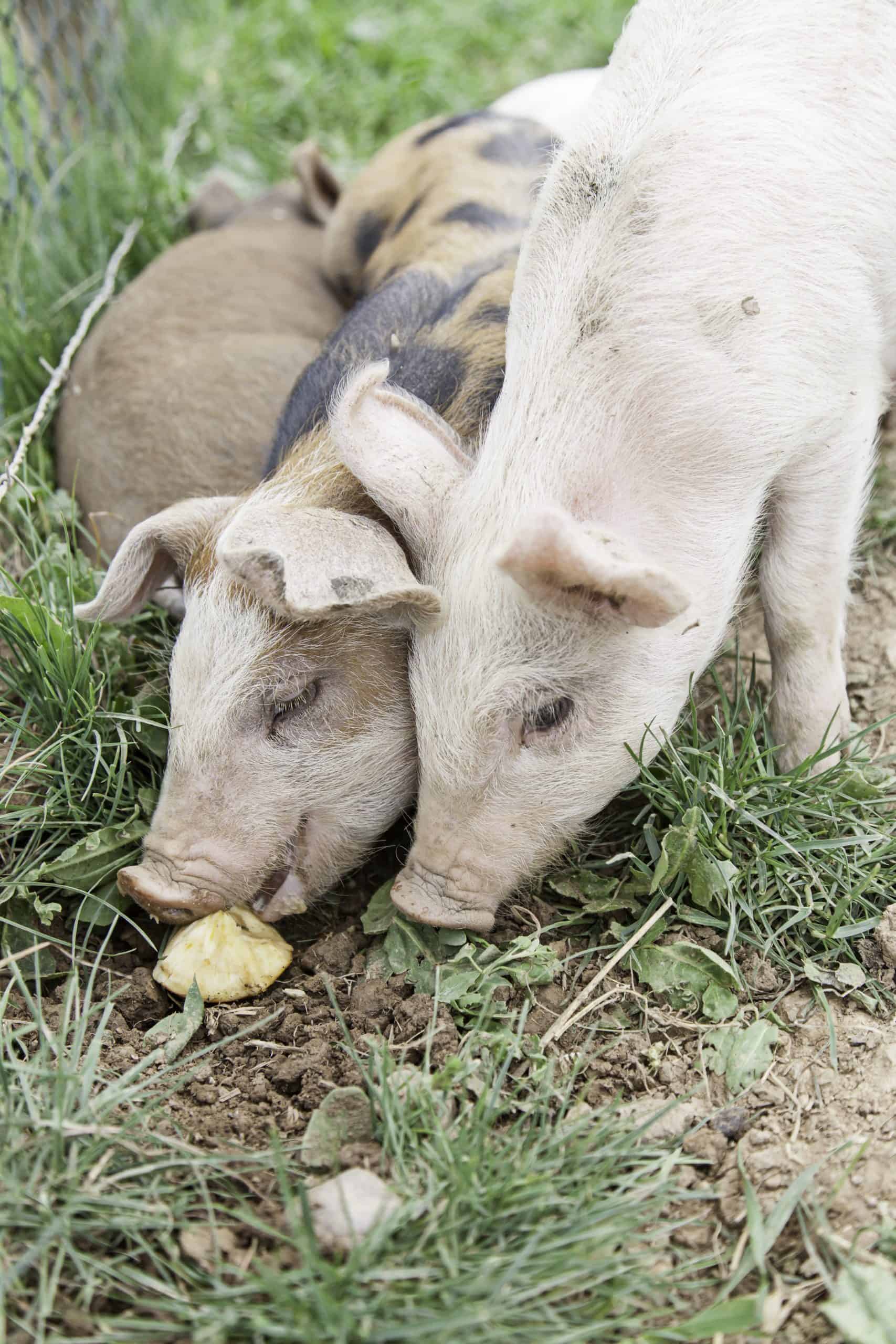What Do Pigs Eat – There is a common misconception that pigs can eat scraps or thrive on any available food. Swine need a well-balanced diet to grow and reproduce. Pigs are omnivores meaning they eat plants and meat. If you are interested in adding pigs to your farm or just curious, here’s what to know about what pigs eat.
What Do Pigs Eat
In the wild, hogs have access to a more diverse diet and can get the nutritional requirements they require. They forage for their food and eat what they can find. They’re omnivorous animals that eat grass, roots, fruits, mushrooms, insects, eggs, and small mammals. Wild hogs don’t naturally have access to human made feed or slop.
What does a pig eat on a farm? On a farm, it’s different depending on the property and location. While foraging opportunities are ideal, farm pigs mostly eat feed provided by farmers. This is a way for pigs to stay healthy in an enclosed environment.
Typically, you should feed pigs a diet consisting of corn with soy or other grains through to finishing. Towards the end (often considered a finishing diet), with certain breeds, such as the Mangalitsa pig, you can add barley to improve the fat quality and the meat marbling. Some farmers might finish their pigs with things like hazelnuts which can give an even more unique flavor to the meat.
Most pig feed includes a mix of:
- Corn
- Soybean
- Grains
Corn
An essential staple of a pig’s diet, corn is high in carbohydrates and easy to digest. It’s an affordable source of energy for farm pigs. For pigs, you will want to make sure the corn is broke down in some way before feeding it. Most farmers will use ground corn but cracked or steam flaked corn is a good alternative.
Soybean
Farmers and feed manufacturers use soybeans because of their high protein content. They’re also a good source of carbs and fat, two important nutrients that support growth in pigs.
Pigs need feed that is rich in protein so they can synthesize the amino acids they need. There are 22 amino acids that exist, and ten of these amino acids are crucial for a healthy pig. Amino acids are building blocks that pigs use to develop protein and gain muscle.
While soybeans are rich in protein and amino acids, they don’t contain the ten different amino acids that pigs need.
Grains
Farmers feed domesticated pigs farm-grain based feeds. You’ll find ingredients like wheat, sorghum, barley, or oats to introduce a wider range of essential amino acids in hog feed.
Foraging and Grazing on Pasture
For pigs who forage or graze, they won’t require as many grains as pigs who don’t. As an example, Kunekune pigs are excellent grazers and won’t need as much grain to reach market weight as some other pig breeds. A new pig breed that was created to be a true grazing pig are Idaho Pasture pigs. Also called IPPs, Idaho Pasture pigs are able to eat the grasses instead of uprooting them because they have shorter snouts.
When raising pigs on pasture, it is important they are high in protein. Grazing on a variety of grasses and legumes, including alfalfa, will help them get the nutrients they require. However, most pig breeds will not be able to survive on grass alone. This is because the nutrients in grass are not all available to a pig because of the way they digest food. You may need to supplement with feed depending on what they have access to.

What Do Pigs Eat on a Farm
What to feed pigs depends on why you’re raising pigs and what kind of lifestyle the animals have. For example, a meat pig and farm pigs will eat differently than a pet pig.
You’ll also find different types of feeds adapted to different life stages. When feeding pigs, you should know that these animals can digest a wide range of food.
However, farmers need feed that is cost-effective and that supports growth while reducing risks of health problems. The traditional mix of corn, soybeans, minerals, and grains achieves this purpose well, but some variations exist in this formula.
It’s important to consider the unique lifestyle and nutritional requirements of farm animals when choosing a feed. For instance, when feeding pigs who have access to a pasture and who graze all day, they will need smaller quantities of grains. On the other hand, a sow that is gestating or lactating will need more water, more nutrients, and possibly a lysine or mineral supplement.
What Do Piglets Eat
What do piglets eat? During the first week of their lives, baby pigs only drink milk. They can start eating solid food after a week, but their digestive system doesn’t have the enzymes required for digesting ingredients like corn.
Piglet feed typically includes probiotics and enzyme supplements to support digestion and help young swine develop a healthy digestive system and gut flora.

There are different types of feed available for piglets:
- Creep feed mostly contains milk proteins. This type of feed is an addition when enough milk isn’t available.
- Pre-starter feed contains a mix of milk protein and grains. It’s a good option until older piglets before they go on a completely solid food diet.
- You can introduce starter feed or weaning feed shortly before piglets stop drinking milk. This type of feed contains ingredients like sorghum, soybean, peanuts, sunflower seeds, and more. These ingredients provide a mix of protein, fat, and fiber while remaining easy to digest.
You can use starter feed until piglets reach 45 lbs. It’s a great option if you’re looking for fast growth. Farmers often use starter feed for piglets they intend on selling or use as show pigs.
Grower/Finisher Feed and Commercial Feed
Grower and finisher feeds are a type of food that farmers can use to get animals to gain as much weight as possible in a short time frame. Pigs are animals that can grow fast, but they need the right feed to fulfill their potential.
On average, pigs can gain 1.5 to 1.7 pounds a day until they reach 110 pounds. They can eat as much as 5% of their body weight a day during. As they get older, they can gain as much as 2 lbs a day.
In most commercial barns, piglets will be removed from their mother anywhere from 3-6 weeks old. At this time, they will be moved into pens where they have access to solid feed and water 24/7. Another tool that commercial farmers will utilize is “phase feeding” which allows the farmer to change the diet to fit the size and nutritional needs of the pigs.
Pigs grow quickly which means their nutritional needs also can change quickly. By tweaking the diet often, farmers can grow a large amount of pigs in a short amount of time with as little input costs as possible. There can be anywhere from 3-12 phases from the time that a pig is weaned, up until it is brought to market.
Grower and finisher feed provides a mix of protein, fat, minerals, and vitamins to help pigs gain weight fast while also staying healthy. It’s low in fibers and usually includes a lysine supplement to promote muscle development. You’ll often find ingredients like sorghum and soybean because of their high protein supplement, and some grower feed manufacturers use additional protein supplements.
The main priority of commercial feed is to offer an affordable feed that farmers can use to raise pigs and offer reasonably-priced meat to consumers.
Depending on their size, farm pigs eat 6 – 8 pounds of feed each day.
What Do Pigs Eat Outside of Grower or Commercial Feed
Other types of feed are an option when cost-effective meat production isn’t the objective. You can, for instance, find a high-quality feed with high levels of crude protein that support muscle definition. It’s a popular option for show pigs or for producing lean pork. Some manufacturers offer feed additives that can boost lean muscle mass production by more than 30%.
Different pig breeds have different requirements.
Foraging breeds like Berkshire, Choctaw, Mulefoot, or Hampshire pigs have a more diverse diet. They need grain to supplement their grazing, but their diet can include grass, peas, turnips, acorns, berries, and legumes. This makes raising Berkshire pigs and other good foragers a good return on investment.
In the wild, hogs will eat plants and animal proteins and overall will have a much more diverse diet.
Pet pigs have very different nutritional requirements compared to farm animals. You can find pellets that use ingredients like ground corn, soybean, oatmeal, flaxseed, alfalfa, wheat, and more. Many mini pig owners supplement their pet’s diet with hay, fruits, and vegetables.

Pigs and Supplements
Farmers often use supplements to introduce more minerals and vitamins and make up for any nutritional deficiencies in the pig feed they are using.
These vitamins and minerals support important metabolic functions. There are a total of ten crucial minerals that pigs need to be healthy, including sodium, chloride, iron, zinc, iodine, selenium, copper, and more.
Farmers can adjust the levels of these different minerals. For instance, they can add more chloride to support a healthy fluid balance or introduce an iron supplement to prevent anemia, a common issue in pigs who aren’t raised outdoors.
Zinc is an important mineral for skin health and reproductive functions, so farmers sometimes increase zinc intake in pigs used for breeding.
How Much Water Does a Pig Need Each Day?
Access to clean water is crucial for raising healthy swine. Over 50% of a pig’s body weight is water. On average, pigs drink two to three kilos of water for each kilo of dry feed they eat, and this amount increases for lactating sows. This translates from less than half a gallon a day for newly weaned pigs to 6 gallons a day for a lactating sow.
Water quality is important. It shouldn’t contain high levels of minerals, nitrates, or sulfates.
You can give a pig water by making sure you have access and space around the waterer. Provide one waterer for every 10 pigs. These can be automatic nipple waterers or large drink bowls. They should be convenient and easy to fill as well as to clean.
FAQs
What do pigs eat naturally?
Pigs are omnivores and eat plants and animals. When permitted to forage and scavenge, pigs eat grasses, leaves, roots, and flowers. They will also eat small animals, eggs, and fish.
Will pigs actually eat anything they find?
Many pigs will eat almost anything, even if it’s not edible. Pigs eat vegetables, table scraps, meat, bread, fruit, pig pellets, and more. However, just because they will eat anything doesn’t mean you should feed them anything. Don’t feed them rotting compost or garbage. Pigs can eat meat.
What is the best food for pigs?
Feeding pigs a diet filled with carbohydrates for energy, protein, and so they put on weight quickly is important for most pig farmers. Corn-based feeds are popular. Pet pigs and pigs raised in backyards often enjoy the bounties of table scraps and fruits and vegetables as well.
Can you feed pigs slop?
Many hog farmers will supplement with pig slop.
What can pigs not eat?
When feeding pigs, it’s tempting to toss them table scraps and leftovers. However, pigs shouldn’t eat pits, avocado peels, nightshades such as eggplant, chocolate, raw meat, raw eggs, or kale.
Is it bad to feed pigs meat?
Cooked meat in moderation is fine for pigs. They shouldn’t eat it raw due to the risk for disease.
Conclusion
What do pigs eat? In most cases, meat pigs eat feed designed to help them gain weight fast with a mix of corn, soybean, and grains. When they are young, they will eat starter and/or grower feed.
When raising meat pigs versus a pet pig, you’ll want to fatten them up to get ready for slaughter. Grain feeds such as barley, oats, wheat, and corn are ideal as they provide energy.
If you’re looking for feed to raise farm pigs, keep in mind that it’s important to consider growth and meat production goals as well as whether they will be foraging for leaves, roots, stems, flowers.
Learn more:

